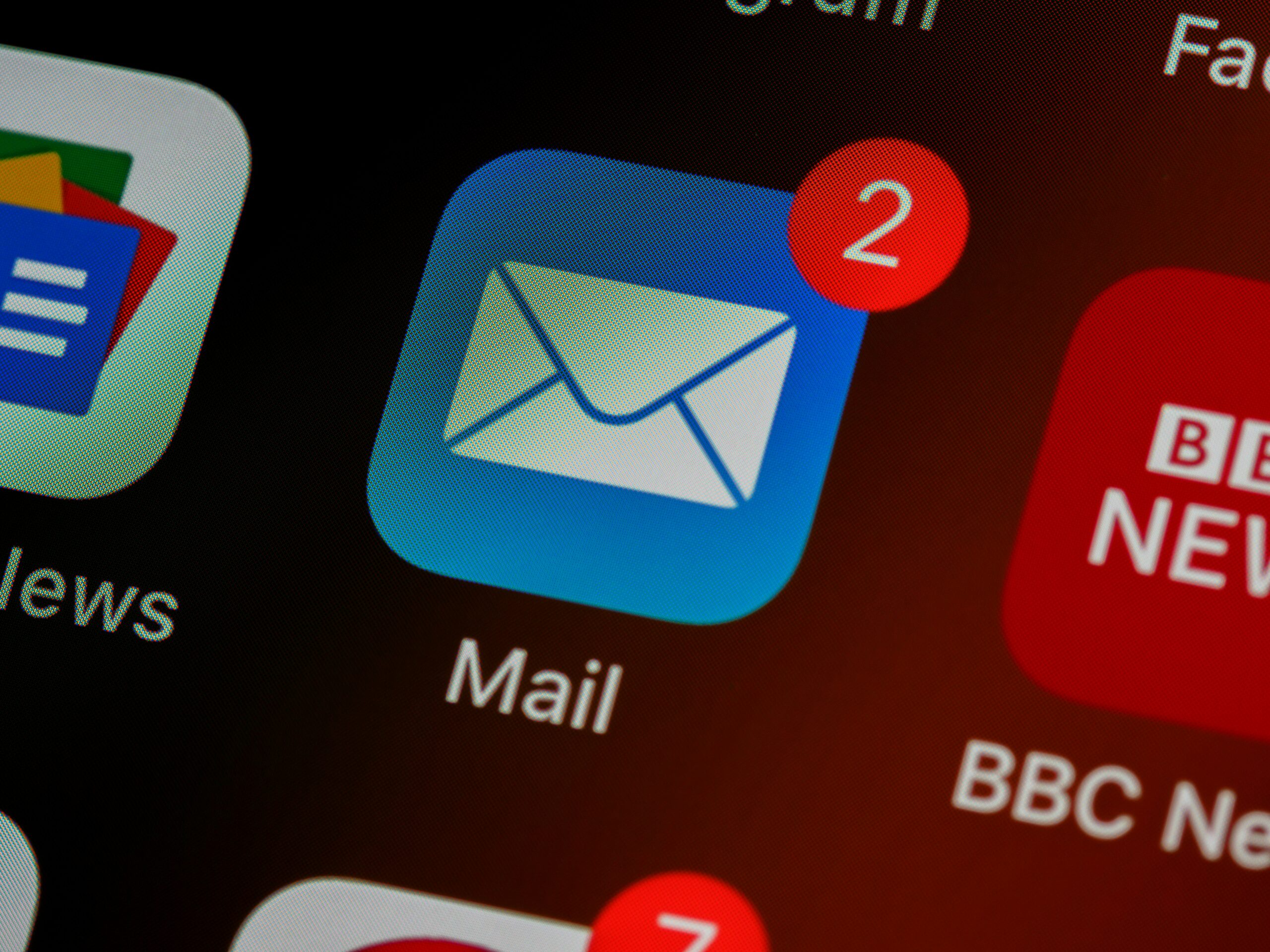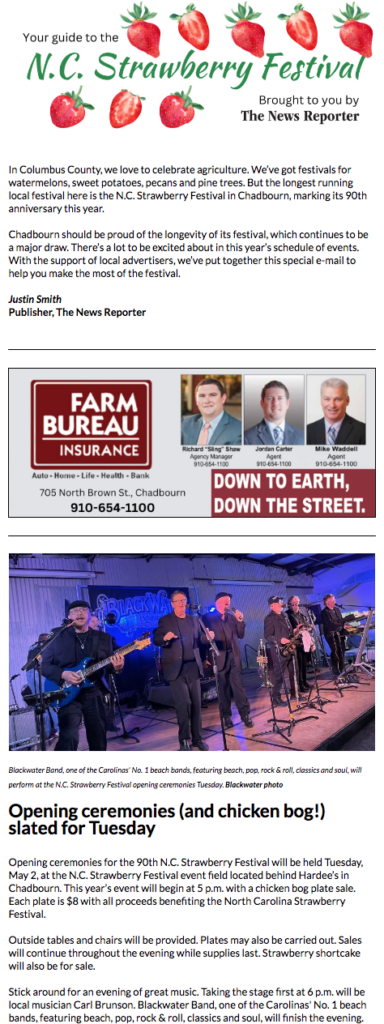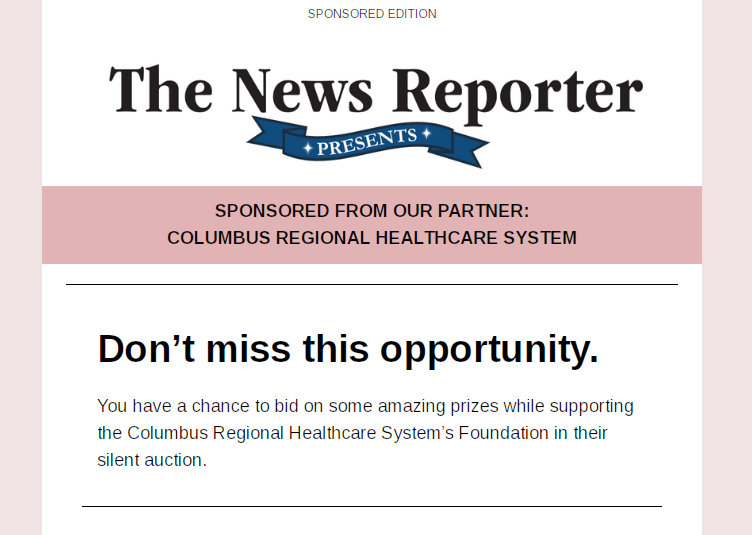4 ways The News Reporter generated new digital revenue through email newsletters
Justin Smith and Rachel Smith, The News Reporter,
(Brett Jordan/Unsplash)
Here’s an idea to steal and adapt: Build your audience with “daily briefing” emails, then leverage that audience for additional advertising and subscription revenue.This is a series on Better News to a) showcase innovative/experimental ideas that emerge from the Knight-Lenfest Newsroom Initiative and b) share replicable tactics that benefit the news industry as a whole.
This “win” comes from Rachel Smith, director of strategic initiatives, and Justin Smith, publisher and editor of The News Reporter in Columbus County, North Carolina, which participated in the UNC Table Stakes program in 2017-18 and 2022-23.
This piece was one of Better News’ most viewed of 2024. Check out the full top 10 list here.
Founded in 1896, The News Reporter was printed twice a week for 126 years. In the late ’90s, The News Reporter launched a website. But for the next two decades, news usually ended up online after it had been published in print.
In 2018, the staff at The News Reporter participated in the UNC Table Stakes program and made the shift to a digital-first newsroom while still printing the newspaper twice a week. This model served the business and community well for four years, until decreasing print advertising revenue and changing reader habits called for the next phase.
In August 2022, publisher Justin Smith announced a “digital expansion” for The News Reporter, along with a shift to printing weekly. After generations of printing twice a week, we knew this would be an adjustment for some readers, but we hoped adding a Daily Briefing email newsletter would help ensure readers’ value for their subscription. We also saw how social media algorithms were de-emphasizing news content, so we knew reaching a digital audience directly would be essential in the coming years.
Our other goals for the Daily Briefing included increasing digital advertising revenue, growing our audience and moving readers down the subscription funnel. At that time, The News Reporter was using Mailchimp to send an email twice a week with a link to the digital replica of the newspaper, but this email included no other content or advertising.
To change that, we created a template for the Daily Briefing in Mailchimp with content and ad blocks; a member of the advertising team places those ads each week. In addition to Justin, who serves as news editor and publisher, our editorial staff includes an assistant editor/reporter and two reporters. Each weekday, Justin chooses the content for the day’s newsletter and one of the three reporters compiles the newsletter around 4 p.m. The briefing goes out every evening.
Here are four highlights from implementing our Daily Briefing email newsletter:
Grow your audience and your digital revenue with daily weekday newsletters
What we did and why: We started with a list of about 5,000 email addresses from two sources: our database of current and previous paid newspaper subscribers and contacts who had opted in to our emails through contests and other promotions. We pushed Daily Briefing sign-ups through our website, social media accounts and print ads in the weekly paper. Additional contests grew our audience to its current size of almost 8,000 email subscribers.
What worked well: Our advertising department has had great success selling digital ads for email newsletters. Some advertisers who have not had interest in digital ads on our website are regulars in our Daily Briefing, and we currently have a waiting list of advertisers for this product. Adding these options to our digital offerings helped us increase digital advertising revenue by 63% in one year.
What didn’t work as expected: Initially, we only had five pieces of content and five ads for each day’s newsletter. Since we had such high interest from advertisers, we added another piece of editorial content to accommodate a sixth ad. This is a good problem, but producing a sixth piece of content can be challenging on some days given the small size of our news staff.
Try this:
- Use editorial content you already have. Most pieces of content in our Daily Briefings are repurposed versions of the latest stories on our website. We include the image associated with the story, the headline and a small excerpt. Readers can click a link that takes them to our website, where content is behind a metered paywall.
- Use stand-alone photos with cutlines as additional content blocks. This is a great way to feature submitted photos that don’t warrant a full story.
- If your advertising spots are limited and in-demand, don’t be afraid to raise rates. Advertisers like seeing their ads every evening in their inbox — and knowing that thousands of readers across Columbus County are seeing them, too.
Want more Better News? Sign up for our monthly newsletter.
Increase your ad inventory with special emails beyond the daily weekday briefing

An excerpt from The News Reporter’s first event-specific email for The N.C. Strawberry Festival (The News Reporter)
What we did and why: Because of limited advertising inventory in our Daily Briefings, we started producing occasional standalone emails to create opportunities for additional advertisers. These one-off emails coincided with special publications that were already a part of our annual schedule. Many of these publications relate to special events in our community. Our first attempt was a series of two emails in spring 2023 for the North Carolina Strawberry Festival. That fall, we added a Pigskin Preview email ahead of the high school football season and two emails for the Columbus County Fair.
What worked well: These emails proved appealing to our regular email advertisers and to new advertisers. We were able to target businesses and organizations in the town where the Strawberry Festival is held, football supporters for Pigskin Preview and businesses related to agriculture for the fair emails.
What didn’t work as expected: We were used to the Daily Briefing format but had to shift gears for these more specialized emails.
Try this:
- Consider two emails for multi-day events: one as a preview and one during the event. For example, for the fair, the first email went out the day before the event opened. Then a few days later, we sent a second email featuring photos and coverage of the fair opening and highlighting the upcoming half-price night and remaining activities at the fair.
- Use a variety of content to fill newsletters: links to stories published online, stand-alone images with cutlines, short original content, event schedules and “look back” photos all work.
- Think outside of the box for advertisers. These one-off newsletters were a good way for new advertisers to stick their toes in the water. This can also be an upsell for print-only advertisers.
Tweak your emails for better user and advertiser experience
What we did and why: Although our format has largely stayed the same, we have made small changes to improve reader experience.
What worked well: Our readers enjoy the email format as a way to stay up to date on local news on a daily basis. Unlike an endless social media feed, the Daily Briefing can be read in one sitting, providing a sense of completion. Although we added the sixth content block for additional ad space, we don’t plan on adding further content so we can maintain the same manageable feel for readers.
What didn’t work as expected: Even though our open rate has been above industry standards (averaging 45%), our click rate has been lower and varies with each campaign. We have been experimenting with ways to increase our click rate, including linking to each story in two ways (with text and picture), and decreasing the amount of text in ads to make them easier to read and more compelling.
Try this:
- Keep ads simple with less text, since many users will be reading on their phones. (We implemented a rule of fewer than 35 words for email newsletter ads.)
- Try recurring features for additional content. Take advantage of any services and training offered by your email platform (Mailchimp, in our case) to organize and grow your audience, increase open/click rates and better reach your readers.
Consider sponsored content and other verticals
What we did and why: One of our goals moving forward is to launch additional types of newsletters, including more event-based and sponsored emails.
What worked well: We partnered with one of our top advertisers for our first stand-alone sponsored email, which promoted a fundraiser and silent auction. Our only hesitation was how our email audience would respond, and we braced ourselves for complaints and unsubscribes, but we were surprised by how well the campaign went. All of our stats (open rate, click rate, number of unsubscribes) were similar to our daily emails and we received no pushback from subscribers.

The News Reporter’s first sponsored email was image-heavy and optimized for scrollability. (The News Reporter)
What didn’t work as expected: Although we have ideas for verticals (public safety, family activities, summer guides, etc.), it has proven difficult to work additional emails into our workflow given our small staff.
Try this:
- Approach loyal advertisers about their needs for a sponsored email, especially around a special event or milestone.
- Consider repurposing stories from print for content verticals, like public safety notices for a community safety newsletter.
- Set goals for integrating new emails into your regular workflow. Since this has been more challenging for us, our first goal is one per quarter, and we plan to scale up from there.
In addition to increasing advertising revenue, we’ve seen additional benefits from our Daily Briefing and other email newsletters. Signing up for our emails is a free way for potential subscribers to build a daily routine with our content. The links in each newsletter also drive readers to our website, which has a metered paywall. We have found that a portion of newsletter readers become subscribers when they hit the paywall on a regular basis. For current subscribers, the Daily Briefing serves as a retention tool — many readers have shared how much they enjoy the newsletters and feel that it provides more value to their digital subscription.
There has been one additional unexpected benefit from our launch of email newsletters: relationship building between readers and reporters. Each weekday, Justin or one of the reporters writes a brief intro that opens the Daily Briefing. It’s about 150 words and the topic is up to the reporter. Intros have included behind-the-scenes looks into the newsroom, what reporters did over the weekend, recipe suggestions and reflections from community events. It’s a great opportunity to humanize our journalists and remind readers that they are part of the community, as well.